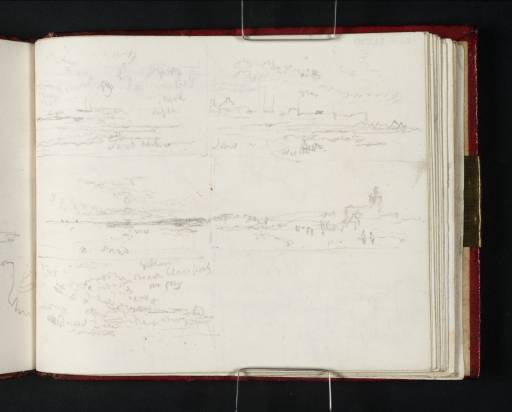Joseph Mallord William Turner Five Studies of Skies 1818
Image 1 of 2
Joseph Mallord William Turner,
Five Studies of Skies
1818
Joseph Mallord William Turner 1775–1851
Folio 23 Verso:
Five Studies of Skies 1818
D13494
Turner Bequest CLXVI 23a
Turner Bequest CLXVI 23a
Pencil on white wove paper, 90 x 112 mm
Accepted by the nation as part of the Turner Bequest 1856
References
1909
A.J. Finberg, A Complete Inventory of the Drawings of the Turner Bequest, London 1909, vol.I, p.482, CLXVI 23a, as ‘Five studies of skies.’.
With the sketchbook inverted Turner has divided this page into six sections (two across, three down), in which he has drawn five small studies of skies (the bottom right section is blank). The studies record the appearance of the sky over coastal areas with diverse weather conditions and at different times of day, varying from brooding grey cloud, to a tranquil sunrise, a clear day and a dramatic multicoloured sky. Although his interest is in the skies, four of the sketches relate the sky to the land or sea, two of which have recognisable topographical settings. There are also boats, buildings and people, all clearly depicted in miniature.
The sketch to the top left looks out to sea with a ‘sand bank’ in the foreground. The picture is divided at roughly the middle point by the horizon, below which the silhouette of a boat can be seen. The sky is filled with jagged-edged clouds, the bottom portion of which contain light hatching and are marked ‘grey’. The picture is full of contrasts as the top right portion is ‘y[ellow]’ with ‘dark’ sky beneath and a ‘light’ sea at the bottom to the left and right. There is another inscription to the right of the boat which is indecipherable.
The study to the top right shows a ‘dark’ and ‘grey’ cloudy sky above a harbour with ‘sand’ to the left and ‘wa[ter]’ to the right. The location is likely to be Dunbar harbour as seen from the beach to the east. On the left are the harbour buildings with the masts of boats in the centre, then the harbour wall and the rocks of Dunbar on the right. Dunbar, circa 1823 (watercolour, private collection)1 was one of Turner’s subjects for the Provincial Antiquities and this is the only sketch of it in which he pays particular attention to the weather. The illustration, although not showing this view, was equally grey and stormy.
In the centre left sketch we look along a beach and out to sea at the rising sun. There are two discs, one above the other, in the sky. Turner has either changed the position of the sun (perhaps tracking its route through the sky – as in a sketch of 1822: Tate D17512; Turner Bequest CC 3 – experimenting with composition, or correcting a mistake), or is showing an effect of the light. Indeed the lower portion of the sky is shaded in to show such effects. The sea to the right is dark and there are three dark silhouettes of figures or buildings on the ‘sand’ in the distance to the left. This beach is probably somewhere along the East Lothian Coast near Dunbar or North Berwick, and may be somewhere like Peffer Sands near Scoughall.
To the right of this study is a view of a town on a clear day. In fact there is no indication of the weather and Turner may in this drawing be interested only in topography. The town may be on the coast (with the sea to the left) and there are hills in the distance. A prominent towered building dominates the few buildings that surround it and there is a crowd of silhouette figures as well as two more clearly depicted figure in the right foreground. The towered building, presumably a church, is depicted again in the Scotch Antiquities sketchbook (Tate D13637; Turner Bequest CLXVII 31a), which shows a view along the coast to what may be Dunbar Harbour (Tate D13638; Turner Bequest CLXVII 31b).
The final sketch at the bottom of the page concentrates exclusively on the multicoloured sky: ‘yellow | Brown cloud [?]mainly | one grey’. The clouds are shaped by a strong wind, and the sun is low in the sky on the right.
There are three similar thumbnail sketches of skies on folio 6 (Tate D13459; Turner Bequest CLXVII 6) of this sketchbook. Although Turner generally concentrates on topographical views in the three Scottish sketchbooks of 1818, there are several examples of cloud and sky studies, and notes on the colour of skies on sketches throughout the book. Many of Turner’s watercolour illustrations for the Provincial Antiquities feature dramatic skies and weather, especially his coastal subjects (Dunbar, circa 1823, private collection; Tantallon Castle, 1821, Manchester City Art Galleries; and Bass Rock, 1824, Lady Lever Art Gallery, Liverpool) as well as Borthwick Castle (1818, Indianapolis Museum of Art).2 (For more on Turner’s depiction of skies and the weather see Tate D13394; Turner Bequest CLXV 41a in the Bass Rock and Edinburgh Sketchbook).
Thomas Ardill
December 2007
How to cite
Thomas Ardill, ‘Five Studies of Skies 1818 by Joseph Mallord William Turner’, catalogue entry, December 2007, in David Blayney Brown (ed.), J.M.W. Turner: Sketchbooks, Drawings and Watercolours, Tate Research Publication, December 2012, https://www


